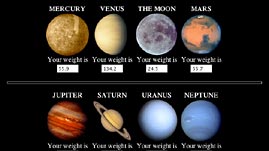Teachers' Domain - Digital Media for the Classroom and Professional Development
User: Preview

Source: Ron Hipschman, Exploratorium. Note: This media resource is not served or maintained by Teachers' Domain.
Gravity exerts a powerful force on all of us -- relentlessly pulling us toward Earth's surface. Everything we do, from standing up and running to getting dressed and eating breakfast, requires us to expend energy, and much of that energy goes toward our struggle against gravity. However, despite the powerful force that gravity exerts, we take it for granted precisely because of its constancy. This interactive resource from the Exploratorium gives you the opportunity to imagine how the differing gravities on other celestial bodies would affect your weight.
Lunar astronauts knew roughly what to expect when they landed on the Moon. Still, nothing could have entirely prepared them for moving around in a gravity that is one-sixth what we experience on Earth. An astronaut who weighed 73 kilograms (160 pounds) on Earth weighed less than 12 kilograms (27 pounds) on the Moon. This made leaping a couple of feet off the surface unbelievably easy and keeping one's feet firmly planted on the surface surprisingly difficult, especially when trying to do work.
Other planets and moons in our solar system have gravitational fields that differ from that of Earth. Jupiter's gravity, for example, is roughly 2.5 times that of Earth's, which means that the same 73-kilogram astronaut would weigh 184 kilograms (405 pounds) if he could stand on that planet's surface. The same astronaut hypothetically standing on the surface of the Sun would weigh 1,965 kilograms (4,331 pounds), roughly 27 times more than he weighed on Earth.
Mass is the measure of the amount of matter an object contains. In contrast to weight, mass is constant regardless of where an object is in the universe. As the examples in this interactive activity illustrate, an object's weight can vary dramatically depending upon where it is in the universe. In fact, weight is a direct measure of the pull of gravity between an object and the body on which it is standing. The strength of this gravitational pull varies depending on the mass of the object, the mass of the body, and the distance between them.
The relationship between mass and gravity is a direct one. For example, a planet with double the mass of another will exert twice the gravitational force. However, gravity decreases with distance, at a rate equal to the square of the distance -- and distance is measured from the center of the two objects. This explains why the gravity of Jupiter, whose mass is 318 times that of Earth, is not 318 times Earth's gravity. Jupiter's huge diameter, 11 times that of Earth's, effectively increases the distance between its center and any object on its surface, thus reducing its gravity to a mere 2.5 times that of Earth.
 Loading Standards
Loading Standards Teachers' Domain is proud to be a Pathways portal to the National Science Digital Library.
Teachers' Domain is proud to be a Pathways portal to the National Science Digital Library.
